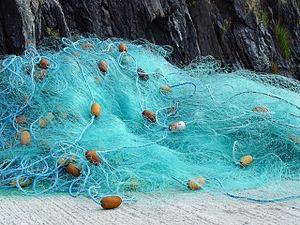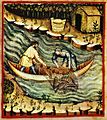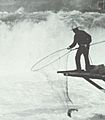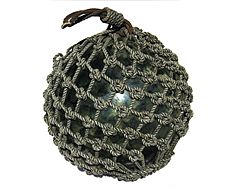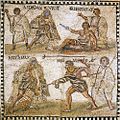Fishing net facts for kids
A fishing net is a net used for fishing. Nets are devices made from fibers woven in a grid-like structure. Some fishing nets are also called fish traps, for example fyke nets. Fishing nets are usually meshes formed by knotting a relatively thin thread. Early nets were woven from grasses, flaxes and other fibrous plant material. Later cotton was used. Modern nets are usually made of artificial polyamides like nylon, although nets of organic polyamides such as wool or silk thread were common until recently and are still used.
Contents
History
Fishing nets in the past
-
Tacuinum sanitatis casanatensis Baghdad 14th century
-
Albrecht Dürer c. 1490-1493
Types
| Type | Image | Description |
|---|---|---|
| Bottom trawl | 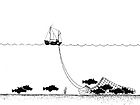 |
Demersal fish such as groundfish, cod, squid, halibut and rockfish. A trawl is a large net, conical in shape, designed to be towed along the sea bottom. The trawl is pulled through the water by one or more boats, called trawlers or draggers. The activity of pulling the trawl through the water is called trawling or dragging. |
| Cast net | 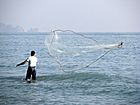 |
Schooling and other small fish. Cast, or throw nets are small round nets with weights on the edges which is thrown by the fisher. Sizes vary up to about four metres in diameter. The net is thrown by hand in such a manner that it spreads out on the water and sinks. Fish are caught as the net is hauled back in. |
| Coracle net fishing | 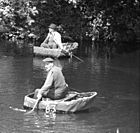 |
Coracle fishing is performed by two people, each seated in a coracle, plying their paddle with one hand and holding a shared net with the other. When a fish is caught, each hauls up their end of the net until the two coracles are brought to touch and the fish is secured. |
| Dragnet |  |
This is a general term which can be applied to any net which is dragged or hauled across a river or along the bottom of a lake or sea. An example is the seine net shown in the image. The fishing depth of this net can be adjusted by adding weights to the bottom. |
| Drift net |  |
The drift net is a net that is not anchored, but is drifting with the current. It is usually a gill or tangle net, and is commonly used in the coastal waters of many countries. Its use on the high seas is prohibited, but still occurs. |
| Drive-in net | A drive-in net is another fixed net, used by small-scale fishermen in some fisheries in Japan and South Asia, particularly in the Philippines. It is used to catch schooling forage fish such as fusiliers and other reef fish. It is a dustpan-shaped net, resembling a trawl net with long wings. The front part of the net is laid along the seabed. The fishermen either wait until a school swims into the net, or they drive fish into it by creating some sort of commotion. Then the net is closed by lifting the front end so the fish cannot escape. | |
| Fixed gillnet (on stakes) |  |
Fixed gillnets are nets for catching fish in shallow inter-tidal zones. It consists of a sheet of network stretched on stakes fixed into the ground, generally in rivers or where the sea ebbs and flows, for entangling and catching the fish. |
| Fyke net |  |
Fyke nets are bag-shaped nets which are held open by hoops. These can be linked together in long chains, and are used to catch eels in rivers. If fyke nets are equipped with wings and leaders, they can also be used in sheltered places in lakes where there is plenty of plant life. Hundreds of these nets can be connected into systems where it is not practical to build large traps. |
| Gillnet |  |
Sardines, salmon, cod. The gillnet catches fish which try to pass through it by snagging on the gill covers. Thus trapped, the fish can neither advance through the net nor retreat. Uses a system of nets with floats and weights. The nets are anchored to the sea floor and allowed to float at the surface |
| Ghost net |  |
Ghost nets are nets that have been lost at sea. They may continue to be a menace to marine life for many years. |
| Hand net | 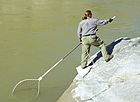 |
Hand nets, also called scoop or dip nets, are held open by a hoop and may be attached to a short or a long stiff handle. They have been known since antiquity and can be used for sweeping up fish near the water surface like muskellunge and northern pike. When such a net is used by an angler to help land a fish it is known as a landing net. In England, hand netting is the only legal way of catching eels and has been practised for thousands of years on the River Parrett and River Severn. |
| Landing net | 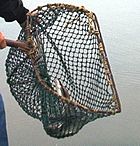 |
Landing nets are large handheld nets that are used to lift caught fish out of the water, most commonly in angling and fly fishing. Landing nets are commonly used for large fish such as the common carp. |
| Lave net | 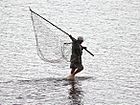 |
A special form of large hand net is the lave net, now used in very few locations on the River Severn in England and Wales. The lave net is set in the water and the fisherman waits till he feels a fish hit against the mesh and the net is then lifted. Fish as large as sturgeon are caught in lave nets. |
| Lift net |  |
A lift net has an opening which faces upwards. The net is first submerged to a desired depth, and then lifted or hauled from the water. It can be lifted either manually (hand lift net) or mechanically (shore-operated lift net), and can be operated on a boat (boat-operated lift net) |
| Midwater trawl | Pelagic fish such as anchovies, shrimp, tuna and mackerel. In midwater trawling a cone-shaped net is towed behind a single boat and spread by trawl doors (image), or it can be towed behind two boats (pair trawling) which act as the spreading device. | |
| Plankton net |  |
Plankton. Research vessels collect plankton from the ocean using fine mesh plankton nets. The vessels either tow the nets through the sea or pump sea water onboard and then pass it through the net. |
| Purse seine | 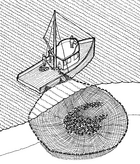 |
Schooling fish. The purse seine, widely used by commercial fishermen, is an evolution of the surround net, which in turn is an evolution of the seine net. A large net is used to surround fish, typically an entire fish school, on all sides. The bottom of the net is then closed by pulling a line arranged like a drawstring used to close the mouth of a purse. This completely traps the fish. |
| Push net | 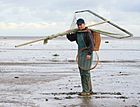 |
A push net is a "small triangular fishing net with a rigid frame that is pushed along the bottom in shallow waters and is used in parts of the southwestern Pacific for taking shrimps and small bottom-dwelling fishes". |
| Seine net | 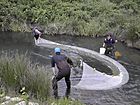 |
A seine is a large fishing net that may be arranged in a number of different ways. In purse seine fishing the net hangs vertically in the water by attaching weights along the bottom edge and floats along the top. A simple and commonly used fishing technique is with beach seine, where the seine net is operated from the shore. Danish seine is a method which has some similarities with trawling. In the UK seine netting for Salmon and Sea-trout in coastal waters is only permitted in a very few locations and where it is permitted one end of the seine must remain fixed and the other end is then waded out and returns to the fixed point. This variant is called Wade netting and is strictly controlled by law. |
| Shore-operated lift net |  |
These are held horizontally by a large fixed structure and periodically lowered into the water. Huge mechanical contrivances hold out horizontal nets with diameters of twenty metres or more. The nets are dipped into the water and raised again, but otherwise cannot be moved. The nets may hold bait or be fitted with lights to attract more fish. The most famous examples are found at Kochi, India, where they are known as Chinese fishing nets (Cheena vala). Despite this name, this technique is used all the world. They are also widely used on the Atlantic coast of France, where they are operated from small huts built over the water on stilts, known as carrelets, and on the Adriatic coast of Italy as trabucco. |
| Surrounding net |  |
A surrounding net surrounds fish on all sides. It is an evolution of the seine, and is typically used by commercial fishers. |
| Tangle net |  |
Tangle nets, also known as tooth nets, are similar to gillnets except they have a smaller mesh size designed to catch fish by the teeth or upper jaw bone instead of by the gills. |
| Trammel | A trammel is a fishing net with three layers of netting that is used to entangle fish or crustacea. A slack central layer with a small mesh is sandwiched between two taut outer layers with a much larger mesh. The net is kept vertical by the floats on the headrope and weights on the bottomrope. |
Fishing lines
Ropes and lines are made of fibre lengths, twisted or braided together to provide tensile strength. They are used for pulling, but not for pushing. The availability of reliable and durable ropes and lines has had many consequences for the development and utility of fishing nets, and influences particularly the scale at which the nets can be deployed.
Floats
Some types of fishing nets, like seine and trammel, need to be kept hanging vertically in the water by means of floats at the top. Various light "corkwood"-type woods have been used around the world as fishing floats. Floats come in different sizes and shapes. These days they are often brightly coloured so they are easy to see.
- Small floats were usually made of cork, but fishermen in places where cork was not available used other materials, like birch bark in Finland and Russia, as well as the pneumatophores of Sonneratia caseolaris in Southeast Asia. These materials have now largely been replaced by plastic foam.
- Subsistence fishermen in some areas of Southeast Asia make corks for fishing nets by shaping the pneumatophores of Sonneratia caseolaris into small floats.
- Entelea: The wood was used by Māori for the floats of fishing nets
- Native Hawaiians made fishing net floats from low density wiliwili wood.
- Glass floats were large glass balls for long oceanic nets, now substituted by hard plastic. They are used not only to keep fishing nets afloat, but also for dropline and longline fishing. Often larger floats have marker flags for easier spotting.
- Glass floats are popular collectors’ items. They were once used by fishermen in many parts of the world to keep fishing nets, as well as longlines or droplines afloat.
Weights and anchors
The Cucuteni-Trypillian culture, ce. 5500 BC to 2750 BC, created ceramic weights in various shapes and sizes which were used as loom weights when weaving, and also were attached to fishing nets.
Despite their ornamental value, dog conches are traditionally used by local fishermen as sinkers for their fishing nets.
Other methods of catching fish
Images for kids
-
A retiarius ("net fighter"), with a trident and cast net, fighting a secutor (mosaic, 4th century BC)
-
Cucuteni-Trypillian ceramic weights
-
Scuba diver's net cutter
-
Loggerhead sea turtle exiting from fishing net through a turtle excluder device
See also
 In Spanish: Red de pesca para niños
In Spanish: Red de pesca para niños


